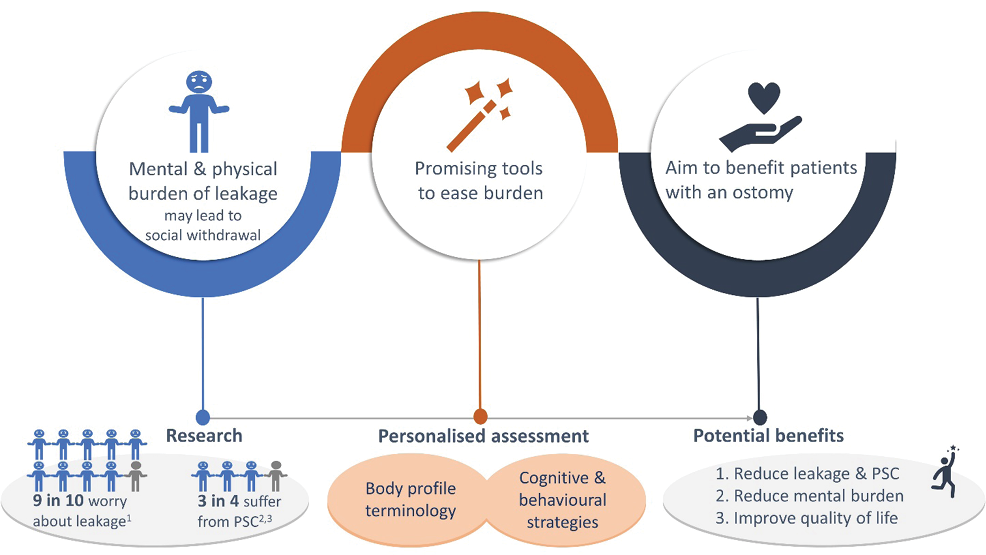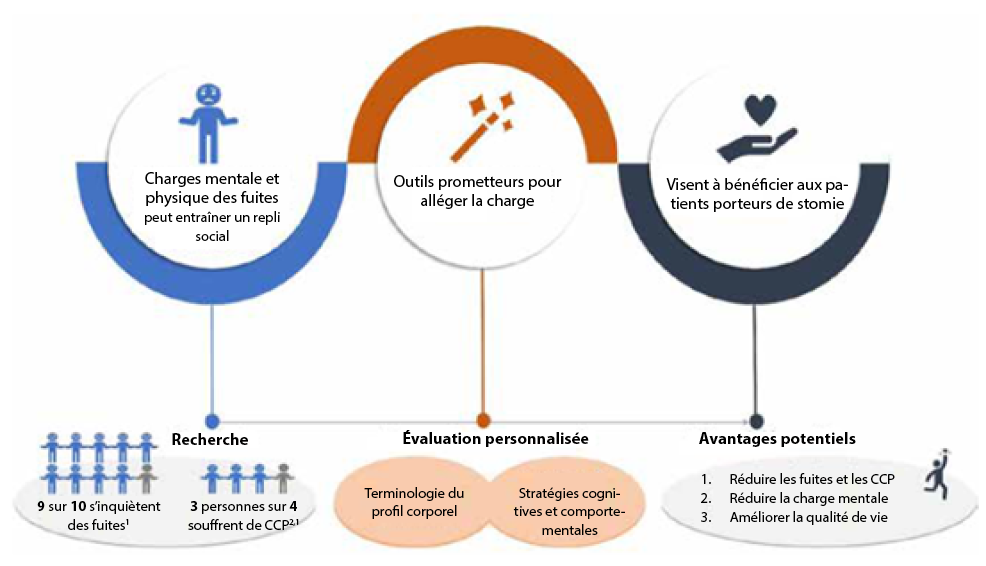Volume 42 Number 2
Editorial
Iben Plate
For referencing Plate I. Editorial. WCET® Journal Supplement 2022;42(1)Sup:s3-4
DOI https://doi.org/10.33235/wcet.42.1.sup.s3-4
The presence and persistence of stoma-related complications following ostomy surgery constitute a major burden for individuals living with an ostomy, a burden comprising physical as well as mental components. The physical component includes leakage of stomal effluent and peristomal skin complications, which may range from mild peristomal dermatitis to full thickness painful skin ulcerations1,2. Additionally, the profound bodily changes following surgery, along with the risk and worry of leakage and complications, may lead to psychosocial problems, including depression, anxiety, low self-esteem and social withdrawal3. These may adversely affect the individual’s adaptation to the stoma and quality of life. Therefore, critical components of ostomy care comprise prevention and management of leakage and skin complications, while helping patients adjust to their changed body and re-engage with their social environment (Figure 1). An insight into these issues is provided in two articles included in the following pages of this WCET supplement.

Figure 1. An overview of the problem of peristomal leakage and skin complications faced by individuals living with an ostomy, and approaches to help mitigate these problems
PSC = peristomal skin complication
1. Claessens I, Probert R, Tielemans C, et al. The Ostomy Life Study: the everyday challenges faced by people living with a stoma in a snapshot. Gastrointest Nurs 2015;13(5):18–25.
2. Salvadalena G, Colwell JC, Skountrianos G, et al. Lessons learned about peristomal skin complications: secondary analysis of the ADVOCATE trial. J Wound Ostomy Continence Nurs 2020;47(4):357–63.
3. Herlufsen P, Olsen AG, Carlsen B, et al. Study of peristomal skin disorders in patients with permanent stomas. Br J Nurs 2006;15(16):854–62.
In the first article, author Janice Colwell argues that one of the most important contributions ostomy care specialists can make to their patients is to help them find the best pouching system in terms of the right size of the skin barrier opening and the best shape (flat or convex) of the skin barrier. While the size of the barrier opening depends on the size of the stoma, the shape of the barrier should be based on a thorough assessment of the patient’s peristomal body profile, the stoma, and the output volume and consistency. The author recommends using a convex solution, particularly if the peristomal area is soft, if there are skin creases/folds, or if the stoma lumen is at or below the skin level4. The importance of reassessing patients on an ongoing basis is emphasised to ensure continued use of the optimal pouching system.
The second article by Anne Steen Hansen and colleagues further discusses the importance of a good fit of the ostomy product to reduce leakage and skin complications. It alludes to a modified Delphi consensus building process involving over 1200 stoma care nurses from 27 countries; this helped to create practical guidelines on how to accurately assess body and stoma profiles. The process was facilitated by Coloplast. The standardised Body Profile Terminology5,6 was recommended for characterising the peristomal body profile of patients. Further highlighted in the second article are results from a scoping review undertaken by a group of ostomy care nurses and physicians; these results indicate that convexity should be considered at all times after ostomy surgery, including in the immediate postoperative period, to secure pouch seal and prevent leakage4.
Overall, the articles emphasise the importance of tailoring ostomy care to include individual preferences and peristomal body profiles to obtain the optimal ostomy solution to prevent leakage and skin complications. By implementing such individualised approaches, ostomy care professionals can considerably improve the lives of the millions of individuals around the world living with an ostomy.
This supplement has been supported by

June 2022
Supplément éditorial
Iben Plate
DOI: https://doi.org/10.33235/wcet.42.1.sup.s3-4
La présence et la persistance de complications liées à la stomie après l’intervention chirurgicale constituent une charge importante pour les personnes vivant avec une stomie, un fardeau comprenant des composantes physiques et mentales. La composante physique inclut la fuite des effluents stomiaux et les complications cutanées péristomiales, qui peuvent aller d'une légère dermatite péristomiale à des ulcérations cutanées de pleine épaisseur douloureuses1,2. En outre, les profonds changements corporels consécutifs à une intervention, ainsi que le risque et l'inquiétude liés aux fuites et aux complications, peuvent entraîner des problèmes psychosociaux, notamment la dépression, l'anxiété, une faible estime de soi et un repli social3. Ceux-ci peuvent avoir un impact négatif sur l'adaptation de la personne à la stomie et sur sa qualité de vie. Par conséquent, les composantes essentielles des soins de stomie comprennent la prévention et la prise en charge des fuites et des complications cutanées, tout en aidant les patients à s'adapter à leur nouveau corps et à se réinsérer dans leur environnement social (figure 1). Un aperçu de ces questions est fourni dans deux articles inclus dans les pages suivantes de ce supplément WCET.

Figure 1. Une vue d'ensemble du problème des fuites péristomiales et des complications cutanées auxquelles sont confrontées les personnes vivant avec une stomie, ainsi que des approches permettant d'atténuer ces problèmes
CCP = complication cutanée péristomiale
1. Claessens I, Probert R, Tielemans C, et al. The Ostomy Life Study: the everyday challenges faced by people living with a stoma in a snapshot. Gastrointest Nurs 2015;13(5):18–25.
2. Salvadalena G, Colwell JC, Skountrianos G, et al. Lessons learned about peristomal skin complications: secondary analysis of the ADVOCATE trial. J Wound Ostomy Continence Nurs 2020;47(4):357–63.
3. Herlufsen P, Olsen AG, Carlsen B, et al. Study of peristomal skin disorders in patients with permanent stomas. Br J Nurs 2006;15(16):854–62.
Dans le premier article, l'autrice Janice Colwell soutient que l'une des contributions les plus importantes que les spécialistes des soins de stomie peuvent apporter à leurs patients est de les aider à trouver le meilleur appareillage en termes de justesse de taille de l'ouverture de la barrière cutanée et de meilleure forme (plate ou convexe) de la barrière cutanée. Alors que la taille de l'ouverture de la barrière dépend de la taille de la stomie, la forme de la barrière doit s’appuyer sur une évaluation approfondie du profil corporel péristomial du patient, de la stomie, ainsi que du volume et de la consistance de l'écoulement. L'autrice recommande d'utiliser une solution convexe, en particulier si la zone péristomiale est souple, s'il y a des plis cutanés ou si la lumière de la stomie se trouve au niveau de la peau ou en dessous4. L'accent est mis sur l'importance de réévaluer les patients de manière permanente afin de garantir l'utilisation en continu de l’appareillage optimal.
Le deuxième article, rédigé par Anne Steen Hansen et ses collègues, traite en outre de l'importance d'un bon ajustement de l’appareil de stomie afin de réduire les fuites et les complications cutanées. Il fait allusion à un processus construit de consensus Delphi modifié impliquant plus de 1200 infirmières et infirmiers stomathérapeutes de 27 pays; ceci a permis de créer des directives pratiques sur la manière d'évaluer avec précision les profils corporel et stomial. Le processus a été facilité par Coloplast. La terminologie standardisée du profil corporel5,6 a été recommandée pour caractériser le profil corporel péristomial des patients. Ce deuxième article met également en évidence les résultats d'une revue de cadrage entreprise par un groupe d'infirmières et infirmiers stomathérapeutes et de médecins; ces résultats indiquent que la convexité doit être envisagée à n’importe quel moment après une chirurgie de stomie, y compris dans la période postopératoire immédiate, pour assurer l'étanchéité de la poche et prévenir les fuites4.
Dans l'ensemble, les articles soulignent l'importance d'adapter les soins des stomies en fonction des préférences individuelles et des profils corporels péristomiaux afin d'obtenir la solution de stomie optimale pour prévenir les fuites et les complications cutanées. En mettant en œuvre de telles approches individualisées, les professionnels des soins de stomie peuvent considérablement améliorer la vie des millions de personnes dans le monde qui vivent avec une stomie.

Author(s)
Iben Plate
Director of Evidence & Adoption, Coloplast A/S
References
- Meisner S, Lehur PA, Moran B et al. Peristomal skin complications are common, expensive, and difficult to manage: a population based cost modeling study. PloS One 2012;7(5):e37813.
- Kwiatt M, Kawata M. Avoidance and management of stomal complications. Clin Colon Rectal Surg 2013;26(2):112–21.
- Ayaz-Alkaya S. Overview of psychosocial problems in individuals with stoma: a review of literature. Int Wound J 2019;16(1):243–9.
- Colwell JC, Davis JS, Emodi K, et al. Use of a convex pouching system in the post-operative period – a national consensus. In press. 2022.
- Global Coloplast Ostomy Forum. Ostomy life study review 2016/17. Coloplast A/S;2017:1–23. Available at: https://www.coloplast.com/Documents/Stoma/CP_MM_OstomyLifeStudy_2016.pdf.
- Colwell JC, Bain KA, Hansen AS et al. International consensus results: development of practice guidelines for assessment of peristomal body and stoma profiles, patient engagement, and patient follow-up. J Wound Ostomy Continence Nurs 2019;46(6):497–504.
